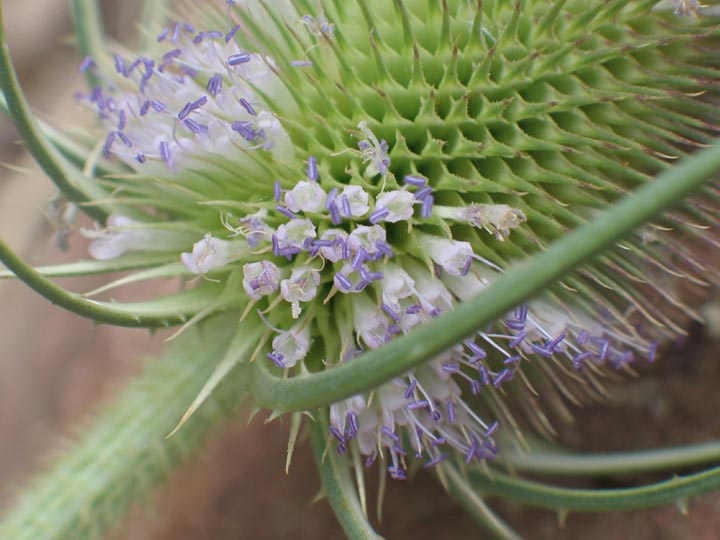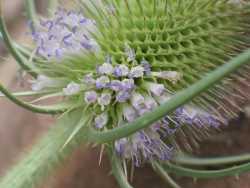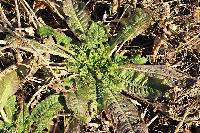Plant: biennial herb, 0.5-2.0 m tall; STEMS angled, furrowed, striate, prickly on the angles, branched above
Leaves: glabrous except for numerous swollen-based prickles on the midrib beneath; basal leaves shortly and inconspicuously petiolate, oblong to oblanceolate, obtuse or acute, entire to crenate, in a rosette, dying early in the second season; cauline leaves lanceolate, sessile, connate at the base forming a cup, 10-30 cm long; lower cauline leaves crenate to serrate; upper leaves entire, often ciliate
INFLORESCENCE: an erect, ovoid to cylindric head, 3-10 cm long, terminating long naked peduncles; involucral bracts prickly, unequal, curving upwards, often surpassing the heads, sometimes foliose but more frequently stiff and narrow; involucel bearing a straight awn
Flowers: calyx silky, 1 mm long; corolla slender, pubescent, 10-15 mm long, the tube white, the lobes 1 mm long, purple
Fruit: 4-angled, with appressed hairs and persistent calyx, 5 mm long
Misc: Fields and roadsides; 2100-2550 m (6900-8400 ft); Jul-Oct
REFERENCES: Laferriere, Joseph E. Dipsacaceae. 1994. J. Ariz. - Nev. Acad. Sci. Volume 27, 201-202.
An obnoxious weed along roadsides, on the banks of streams, and in waste places, fields, and open woods.
Duration: Biennial
Lifeform: Forb/Herb
General: Introduced biennial, 50-200 cm tall; stems erect, stout, striate, angled, prickly on the angles and becoming more so upwards; taprooted.
Leaves: Basal (forming a rosette and usually dying early in the second season) and cauline, opposite, simple, blades more-or-less prickly, especially on the midvein below, otherwise glabrous; basal blades oblong to oblanceolate, margins crenate, apex obtuse to acute; cauline blades 10- 30 cm long, the lower blades crenate to serrate, becoming entire upwards, often ciliate; basal blades short- petiolate, cauline blades sessile and connate at their bases, forming a cup.
Flowers: Inflorescence of terminal cymes with mostly 2-3 branches, sometimes rather open, with the branches up to 8 cm long; sepals 5, lanceolate to oblong-lanceolate, 2-4 (6) mm long, nearly equal, conspicuously spurred; petals 5, lanceolate, 4-7 mm long, 1.5-2 mm wide, white or pinkish at center, apex blunt to broadly acute; flowers July- September.
Fruits: Achene, 5 mm long, 4-angled, appressed-hairy.
Ecology: Moist low sites, roadsides, fields, waste places, disturbed habitats; 2100-2600 m (6900-8400 ft); Coconino and Yavapai counties; widespread throughout North America.
Notes: The Navajo use this plant to card wool. Flowers are also used in dried flower arrangements.
Synonyms: Dipsacus sylvestris, Dipsacus fullonum subsp. sylvestris
Editor: Springer et al. 2008
Long cult. as the fullers' teasel, is rarely adventive with us. It differs from the closely allied wild D. sylvestris in the stouter, strongly recurved spine-tips of its receptacular bracts. Linnaeus included both in his D. fullonum, and the name has subsequently been restricted by different authors to each of them.
Gleason, Henry A. & Cronquist, Arthur J. 1991. Manual of vascular plants of northeastern United States and adjacent Canada. lxxv + 910 pp.
©The New York Botanical Garden. All rights reserved. Used by permission.









